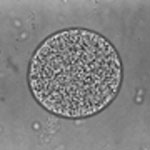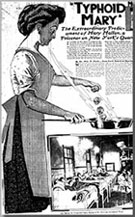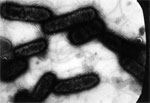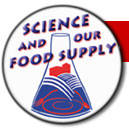|

|
Many normally edible fish and shellfish become poisonous after feeding on toxic
plants or algae. When a person eats a toxic fish or shellfish, the poison attacks
the nervous system and causes a sometimes fatal condition called ciguatera.
This condition is found in some finfish, notably barracuda and amber-jack.
Ciguatera is one of many toxins that fish and shellfish can transmit.
|
|
List of Terms: T
(Return to Comprehensive List of Terms)
> Thermometer(see
Food
Thermometer)
> Toxin
A poison that is produced by microorganisms, carried by fish, or released by plants.
Food Safety Implication: As pathogens multiply, they can give off harmful
toxins or become infectious. If pathogens get into our food and multiply, people
can get sick when they eat the food. To prevent toxins from developing in food,
consumers should not hold food in the danger zone, the temperature range in which
most bacteria can grow. This range is usually below 40° F (4° C). Some
pathogenic bacteria grow at 32° F (0° C) or above 140° F (60°
C). Toxins can develop in foods sitting out at room temperature for more than
2 hours. When in doubt, throw the food out.

Do all toxins in food survive the cooking process?
No, all toxins in food do not survive the cooking process. In fact, the botulism
toxin caused by Clostridium botulinum can be inactivated
by cooking. Boiling food for 10 minutes eliminates this toxin. However, many other
toxins are heat stable. For example, Staphylococcus
can produce toxins that are not destroyed by high cooking temperatures. To prevent
toxins from developing in food, don"t leave food sitting out at room temperature
for more than 2 hours. On a hot day (90° F or higher), food should not sit
out for more than 1 hour.
|
Some Examples of Toxins in Food:
- Mycotoxins - produced by fungi (molds) in food and animal feed (see
Mycotoxins).
- Staphylococcal Toxin - produced by Staphylococcus aureus. This toxin
is the result of improperly-refrigerated foods and is a food-handling problem.
Some Examples of Diseases Caused by Toxins:
- Botulism - caused by the toxin from Clostridium botulinum. The toxin
produced by Clostridium botulinum is one of the most potent and deadly
toxins known to humankind. (See Canning
and Clostridium botulinum.)
- Scombroid Poisoning - caused by histamine in conjunction with other
amino acids produced by bacterial decomposition in some improperly refrigerated
fish, such as mackerel and tuna (especially the scombroid species).
|
|

|
More than 60 million people in the United States are probably infected with
the Toxoplasma gondii parasite, but very few have symptoms because
the immune system usually keeps the parasite from causing illness.
Toxoplasmosis is also transmitted congenitally from an infected pregnant woman
to her baby.
|
|
> Toxoplasma gondii
A parasite that causes toxoplasmosis, a very severe disease that can cause central
nervous system disorders, such as mental retardation and visual impairment in
children.

Toxoplasma gondii
Sources: Raw or undercooked pork, lamb, or venison and cat, rat, rodent,
or bird feces.
Illness
Incubation: Approximately 1 to 3 weeks.
Symptoms: Swollen glands, fever, and muscle aches. People in the at-risk
groups may experience more severe symptoms.
Duration: A few weeks.

When is a traceback investigation necessary?
A traceback investigation is necessary when it is determined that the cause of an outbreak was not due to a point of service (POS) mistake. The POS could be a restaurant, grocery store, caterer, or your table at home. Once the common food is identified and the food source is suspected, the Centers for Disease Control and Prevention notifies the Food and Drug Administration or U.S. Department of Agriculture (whichever agency has jurisdiction over the food). The agency uses traceback techniques to determine the source of the food.
|
> Traceback
A term used in epidemiology to describe the process by which the origin or source
of a cluster of contaminated food is identified.
Food Safety Implication: Tracebacks may stop the additional sale and
distribution of contaminated food, thus preventing further exposure or spread
of the infection. For example, if an outbreak is determined to be caused by a
suspected food, investigators conducting the traceback analysis would determine
where the restaurant or grocery store purchased the food, who supplied the wholesaler,
and finally, on which farm it was grown.
Since wholesalers and retailers often buy food from multiple vendors, the traceback
to the farm step requires extensive detective work. The various stages that the
food traveled would be examined to deduce where the pathogen was transferred to
the product.
> Transduction
A process in which genes from a bacterium are incorporated into the genome or
chromosome of a bacteriophage (a virus that attacks bacteria) and then carried
to another host cell when the bacteriophage initiates a new cycle of infection.
(Also see Bacteriophage.)
> Transformation
The passing of genetic material in the form of deoxyribonucleic acid (DNA) between
bacteria. One bacterium, called the donor cell, gives DNA fragments to another
bacterium, called the recipient cell.
> Transovarian Transfer
When certain pathogens, notably Salmonella Enteritidis, can infect the
ovaries of hens and thus, infect the eggs as they are being formed in the ovaries.
(Also see Competitive Exclusion
and Salmonella.)
Food Safety Implication: Transovarian transfer occurs without harming
the bird or stopping the egg production. The pathogens end up inside the egg (on
the surface of the yolk), so that no amount of washing of the egg shell will remove
or kill the Salmonella Enteritidis bacteria. All eggs laid by an infected
hen do not carry the bacteria, which makes it more difficult to pinpoint the problem.
|
|

|

The New York American, June 20, 1909
Typhoid Mary
(1870 est.-1938)
Mary Mallon, also known as Typhoid Mary, was a famous typhoid carrier who allegedly
attributed to the most famous outbreaks of carrier-borne disease in medical history.
Mary was first recognized as a carrier of the typhoid bacteria during an epidemic
of typhoid fever in 1904 that spread through Oyster Bay, New York, where
she worked from household-to-household as a cook.
She was a healthy carrier of the disease, which meant she had at some point
had a mild case of typhoid and still carried the disease, although she was not
affected. This also meant she could spread the disease.
Fifty-one original cases of typhoid and 3 deaths were directly attributed to
her (countless more were indirectly attributed), although she was immune to the
typhoid bacillus, Salmonella Typhi.
|
|
> Typhoid Fever
A life-threatening illness caused by the bacterium Salmonella Typhi. In
the United States, about 400 cases of typhoid fever are identified each year,
and 75% of these cases are acquired while traveling internationally.

Salmonella Typhi
Sources: Food or beverages that have been contaminated with bacteria
that gets into the water used for drinking or washing food or handled by a person
who is shedding (excreting the bacteria in their stool) Salmonella Typhi.
Illness
Incubation: 1 to 4 weeks, usually 2 weeks.
Symptoms: Fever, stomach pains, headache, loss of appetite, and weakness.
In some cases, patients have a rash of flat, rose-colored spots.
Duration: Once asymptomatic (presenting no symptoms of disease), it
can be ongoing.
See the "Did You Know?" on Typhoid Mary at left and the Frequently Asked Question
below.

If a person who was infected by Salmonella typhi begins to feel okay, does
this mean he or she has stopped shedding the bacteria?
Not necessarily. Even if symptoms seem to go away, a person may still be carrying
Salmonella Typhi. If so, the illness could return
and he or she could pass the disease to other people. In fact, if the person works
at a job where he or she handles food or cares for small children, that person
may be barred legally from going back to work until a doctor has determined that
the person no longer carries any typhoid bacteria. Therefore, it's important for
the person to consult a doctor to ensure that the bacteria no longer remain in
his or her body.
|
|


